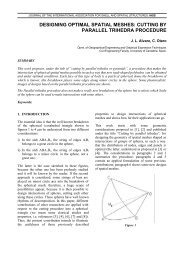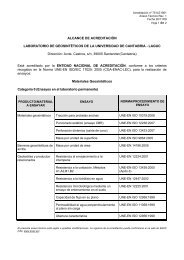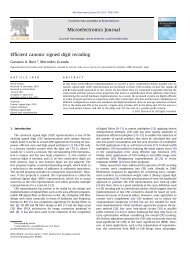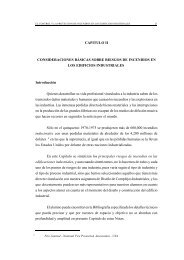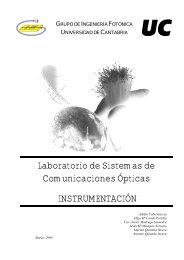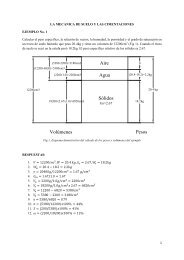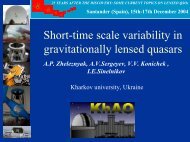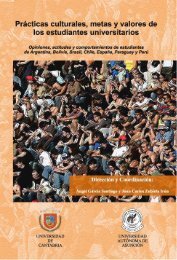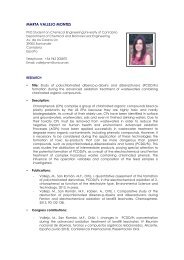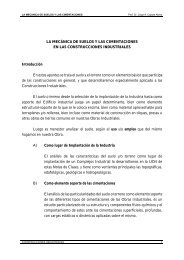37º IAHS World Congress on Housing: - Universidad de Cantabria
37º IAHS World Congress on Housing: - Universidad de Cantabria
37º IAHS World Congress on Housing: - Universidad de Cantabria
- No tags were found...
You also want an ePaper? Increase the reach of your titles
YUMPU automatically turns print PDFs into web optimized ePapers that Google loves.
October 26, 10 h 30–11 h 00 (Room 0)Courtesy: AIDICO. Instituto Tecnológico <strong>de</strong> la C<strong>on</strong>strucción <strong>de</strong> la Comunidad Valenciana.Presentati<strong>on</strong>: D. Javier Yuste Navarro. Director <strong>de</strong> la Unidad Técnica <strong>de</strong> Investigación enSeguridad y Tecnología <strong>de</strong> la C<strong>on</strong>strucción.PROF. FEDERICO M. MAZZOLANIFull Professor of Structural Engineering at the Department of StructuralEngineering of the University of Naples “Fe<strong>de</strong>rico II”.Doctor H<strong>on</strong>oris Causa at Technical University of Bucharest (1995).Doctor H<strong>on</strong>oris Causa at Politehnica University of Timisoara (1996).Charles Mass<strong>on</strong>net award (2001).Member of the Royal Aca<strong>de</strong>my of Engineers of Spain (since 2000)Member of the Aca<strong>de</strong>my of Engineers of Czech Republic (since 2004).Presi<strong>de</strong>nt of the Doctoral School of Civil Engineering CONFIRMADO(since 2005) at theUniversity of Naples “Fe<strong>de</strong>rico II”.Presi<strong>de</strong>nt of the Master in Design of Steel Structures (since 2006) at the University of Naples“Fe<strong>de</strong>rico II”.Chairman of the ECCS-TC 13 Committee “Seismic Design” (1985-2007). Chairman of the CEN-TC250/SC9 Committee “Design of Aluminium Structures” (since 1992). Chairman of the nati<strong>on</strong>al“mirror” committee for Euroco<strong>de</strong> 3 (Steel structures), Euroco<strong>de</strong> 4(Composite steel-c<strong>on</strong>cretestructures) and Euroco<strong>de</strong> 9 (Aluminium structures) (1990-2006). Chairman of the Internati<strong>on</strong>alSTESSA C<strong>on</strong>ferences <strong>on</strong> the “Behaviour of Steel Structures in Seismic Areas” (since 1994).Coordinator of the ILVA-IDEM research project <strong>on</strong> “Seismic upgrading of RC buildings by advancedtechniques (2000-2005). Coordinator of the internati<strong>on</strong>al PROHITECH Project <strong>on</strong> “EarthquakeProtecti<strong>on</strong> of Historical Buildings by Mixed Reversible Technologies” (2004-2008).Chairman of the COST C26 Acti<strong>on</strong> <strong>on</strong> “Urban Habitat C<strong>on</strong>structi<strong>on</strong>s un<strong>de</strong>r Catastrophic Events”(2006-2010). Chairman of the Steering Committee of SIJLAB “Sino-Italian Laboratory for Archime<strong>de</strong>sBridge” (2004-2008). Coordinator of the internati<strong>on</strong>al Sino-Italian REHICO project <strong>on</strong> “Innovativemethodologies for the rehabilitati<strong>on</strong> of historical c<strong>on</strong>structi<strong>on</strong>s” (2006-2009).Member of the Canadian Standard Associati<strong>on</strong> (since 2007). Member of the Board of IAESE(Internati<strong>on</strong>al Associati<strong>on</strong> for Experimental Structural Engineering) (since 2008). Member of the ESFPool of Reviewers (since 2009).His main research topics are: structural analysis and <strong>de</strong>sign, steel and aluminium structures(c<strong>on</strong>necti<strong>on</strong>, stability), earthquake engineering (seismic <strong>de</strong>sign, passive c<strong>on</strong>trol) and structuralrestorati<strong>on</strong> (c<strong>on</strong>solidati<strong>on</strong>, upgrading).He is Author of more than 700 papers in journals and c<strong>on</strong>ference proceedings, 49 m<strong>on</strong>ographs and 34books (26 in English, 2 in Chinese).ABSTRACT: PROTECTION OF HISTORICAL BUILDINGSThe seismic protecti<strong>on</strong> of historical buildings is being looked at with greater and greater interest,above all in the Euro-Mediterranean area, its cultural heritage being str<strong>on</strong>gly susceptible to un<strong>de</strong>rgosevere damage or even collapse due to earthquake. The cultural importance of historical c<strong>on</strong>structi<strong>on</strong>slimits, in many cases, the possibility to upgra<strong>de</strong> them from the seismic point of view, due to the fear ofusing interventi<strong>on</strong> techniques which could have <strong>de</strong>trimental effects <strong>on</strong> their cultural value.C<strong>on</strong>sequently, a great interest is growing in the <strong>de</strong>velopment of sustainable methodologies for theseismic protecti<strong>on</strong> of the existing c<strong>on</strong>structi<strong>on</strong>s.In this c<strong>on</strong>text, this presentati<strong>on</strong> is focused <strong>on</strong> the c<strong>on</strong>cepti<strong>on</strong>, experimentati<strong>on</strong> and mo<strong>de</strong>lling oftechniques for the seismic protecti<strong>on</strong> of historical buildings. The <strong>de</strong>scribed activity has been <strong>de</strong>velopedwithin the “PROHITECH – Earthquake PROtecti<strong>on</strong> of HIstorical Buildings by Reversible MixedTECHnologies” European research project, in which sixteen aca<strong>de</strong>mic Instituti<strong>on</strong>s bel<strong>on</strong>ging to twelveEuro-Mediterranean Countries (Italy, Algeria, Belgium, Egypt, Maced<strong>on</strong>ia, Greece, Israel, Morocco,Portugal, Romania, Slovenia, Turkey) were involved. Within that research project, several seismicprotecti<strong>on</strong> techniques have been studied both in experimental and numerical ways, so that a <strong>de</strong>ep andcomprehensive un<strong>de</strong>rstanding of the faced issues has been achieved.The proposed systems for the seismic protecti<strong>on</strong> of historical c<strong>on</strong>structi<strong>on</strong>s typical of the Euro-Mediterranean area are mainly based <strong>on</strong> reversible mixed technologies, which use, also incombinati<strong>on</strong>, FRP (Fibre Reinforced Polymers) elements, steel sleeves, steel or aluminium shearpanels, steel c<strong>on</strong>nectors.The <strong>de</strong>scribed applicati<strong>on</strong>s show the advantages of the proposed techniques for the seismicprotecti<strong>on</strong> of historically buildings, since they allow to both protect the c<strong>on</strong>structi<strong>on</strong>s in case of seismicevents and to preserve their cultural value.37º <str<strong>on</strong>g>IAHS</str<strong>on</strong>g> <str<strong>on</strong>g>World</str<strong>on</strong>g> <str<strong>on</strong>g>C<strong>on</strong>gress</str<strong>on</strong>g> On <strong>Housing</strong> Science 21



